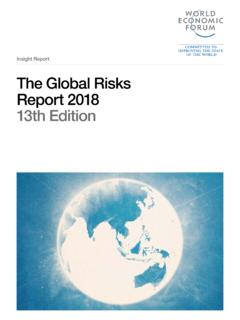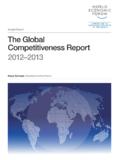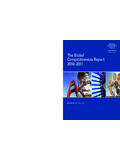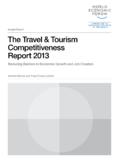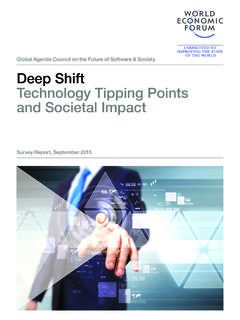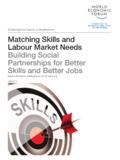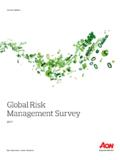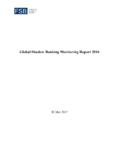Transcription of Insight Report The Global Risks Report 2017 12th Edition
1 Insight Report The Global Risks Report 2017. 12th Edition The Global Risks Report 2017, 12th Edition is published by the World Economic Forum within the framework of The Global Competitiveness and Risks Team. The information in this Report , or on which this Report is based, has been obtained from sources that the authors believe to be reliable and accurate. However, it has not been independently verified and no representation or warranty, express or implied, is made as to the accuracy or completeness of any information obtained from third parties. In addition, the statements in this Report may provide current expectations of future events based on certain assumptions and include any statement that does not directly relate to a historical fact or a current fact. These statements involve known and unknown Risks , uncertainties and other factors which are not exhaustive. The companies contributing to this Report operate in a continually changing environment and new Risks emerge continually.
2 Readers are cautioned not to place undue reliance on these statements. The companies contributing to this Report undertake no obligation to publicly revise or update any statements, whether as a result of new information, future events or otherwise and they shall in no event be liable for any loss or damage arising in connection with the use of the information in this Report . World Economic Forum Geneva World Economic Forum . 2017 All rights reserved. All rights reserved. No part of this publication may be reproduced, stored in a retrieval system, or transmitted, in any form or by any means, electronic, mechanical, photocopying, or otherwise without the prior permission of the World Economic Forum. ISBN: 978-1-944835-07-1. REF: 050117. The Report and an interactive data platform are available at World Economic Forum 91-93 route de la Capite CH-1223 Cologny/Geneva Switzerland Tel.: +41 (0) 22 869 1212. Fax: +41 (0) 22 786 2744. Figure 1: The Risks -Trends Interconnections Map Source: World Economic Forum Global Risks Perception Survey 2016.
3 Note: Survey respondents were asked to select the three trends that are the most important in shaping Global development in the next 10 years. For each of the three trends identified, respondents were asked to select the Risks that are most strongly driven by those trends. The Global Risks with the most connections to trends are spelled out in the figure. See Appendix B for more details. To ensure legibility, the names of the Global Risks are abbreviated; see Appendix A for the full name and description Figure 2: The Evolving Risks Landscape, 2007-2017. Top 5 Global Risks in Terms of Likelihood 2007 2008 2009 2010 2011 2012 2013 2014 2015 2016 2017. Breakdown of Asset price Asset price Asset price Storms and Severe income Severe income Income disparity Interstate conflict Large-scale Extreme weather 1st critical information collapse collapse collapse cyclones disparity disparity with regional involuntary events infrastructure consequences migration Breakdown of critical information infrastructure Chronic disease Middle East Slowing Chinese Slowing Chinese Flooding Chronic fiscal Chronic fiscal Extreme weather Extreme weather Extreme weather Large-scale 2nd in developed instability economy (<6%) economy (<6%)
4 Imbalances imbalances events events events involuntary countries migration Oil price shock Failed and failing Chronic disease Chronic disease Corruption Rising greenhouse Rising greenhouse Unemployment Failure of national Failure of climate- Major natural 3rd states gas emissions gas emissions and governance change mitigation disasters underemployment and adaptation Breakdown of critical information China economic Oil and gas price Global governance infrastructure Fiscal crises Biodiversity loss Cyber attacks Water supply Climate change State collapse or Interstate conflict Large-scale 4th hard landing spike gaps crises crisis with regional terrorist attacks consequences Asset price Chronic disease, Retrenchment Global governance Climate change Water supply Mismanagement Cyber attacks High structural Major natural Massive incident 5th collapse developed world from globalization gaps crises of population unemployment or catastrophes of data fraud/theft (emerging) ageing underemployment Top 5 Global Risks in Terms of Impact 2007 2008 2009 2010 2011 2012 2013 2014 2015 2016 2017.
5 Asset price Asset price Asset price Asset price Fiscal crises Major systemic Major systemic Fiscal crises Water crises Failure of climate- Weapons of mass 1st collapse collapse collapse collapse financial failure financial failure change mitigation destruction and adaptation Breakdown of critical information infrastructure Retrenchment Retrenchment Retrenchment Retrenchment Climate change Water supply Water supply Climate change Rapid and massive Weapons of mass Extreme weather 2nd from globalization from globalization from globalization from globalization crises crises spread of destruction events (developed) (developed) (developed) infectious diseases Interstate and Slowing Chinese Oil and gas Oil price spikes Geopolitical Food shortage Chronic fiscal Water crises Weapons of mass Water crises Water crises 3rd civil wars economy (<6%) price spike conflict crises destruction imbalances Breakdown of critical information Pandemics Oil and gas Chronic disease infrastructure Chronic disease Asset price Diffusion of Unemployment Interstate conflict Large-scale Major natural 4th price spike collapse imbalances weapons of mass and with regional involuntary disasters destruction underemployment consequences migration Oil price shock Pandemics Fiscal crises Fiscal crises Extreme energy Extreme volatility Failure of climate- Critical information Failure of climate- Severe energy Failure of climate- 5th price volatility in energy and change mitigation infrastructure change mitigation price shock change mitigation agriculture prices and adaptation breakdown and adaptation and adaptation Economic Environmental Geopolitical Societal Technological Source: World Economic Forum 20017-2017, Global Risks Reports Note.
6 Global Risks may not be strictly comparable across years, as definitions and the set of Global Risks have evolved with new issues emerging on the 10-year horizon. For example, cyberattacks, income disparity and unemployment entered the set of Global Risks in 2012. Some Global Risks were reclassified: water crises and rising income disparity were re-categorized first as societal Risks and then as a trend in the 2015 and 2016 Global Risks Reports, respectively. The 2006 Edition of the Global Risks Report did not have a Risks landscape Figure 3: The Global Risks Landscape 2017. Source: World Economic Forum Global Risks Perception Survey 2016. Note: Survey respondents were asked to assess the likelihood of the individual Global risk on a scale of 1 to 7, 1 representing a risk that is not likely to happen and 7 a risk that is very likely to occur. They also assess the impact on each Global risk on a scale of 1 to 5 (1: minimal impact, 2: minor impact, 3: moderate impact, 4: severe impact and 5: catastrophic impact).
7 See Appendix B for more details. To ensure legibility, the names of the Global Risks are abbreviated; see Appendix A for the full name and description Figure 4: The Global Risks Interconnections Map 2017. Source: World Economic Forum Global Risks Perception Survey 2016. Note: Survey respondents were asked to identify between three and six pairs of Global Risks they believe to be most interconnected. See Appendix B for more details. To ensure legibility, the names of the Global Risks are abbreviated; see Appendix A for the full name and description The Global Risks Report 2017. 12th Edition Strategic Partners Marsh & McLennan Companies Zurich Insurance Group Academic Advisers National University of Singapore Oxford Martin School, University of Oxford Wharton Risk Management and Decision Processes Center, University of Pennsylvania Contents 4 Preface By Klaus Schwab 5 Foreword 6 Executive Summary 8 Introduction 10 Part 1: Global Risks 2017. Economy: Growth and Reform Society: Rebuilding Communities Technology: Managing Disruption Geopolitics: Strengthening Cooperation Environment: Accelerating Action 22 Part 2: Social and Political Challenges 23 Western Democracy in Crisis?
8 29 Fraying Rule of Law and Declining Civic Freedoms: Citizens and Civic Space at Risk 35 The Future of Social Protection Systems 42 Part 3: Emerging Technologies 43 Understanding the Technology Risk Landscape 48 Assessing the Risk of Artificial Intelligence 53 Physical Infrastructure Networks and the Fourth Industrial Revolution 58 Conclusion 60 Appendices Appendix A: Description of Global Risks , Trends and Emerging Technologies 2017. Appendix B: Global Risks Perception Survey 2016 and Methodology 68 Acknowledgements Preface As in previous years, the analysis contained in this Report builds on the annual Global Risks Perception Survey, completed by almost 750 members of the World Economic Forum's Global multistakeholder community. The year 2017 will present a pivotal moment for the Global community. The threat of a less cooperative, more inward-looking world also creates the opportunity to address Global Risks and the trends that drive them. This will require responsive and responsible leadership with a deeper commitment to inclusive development and equitable growth, both nationally and globally.
9 It The year 2016 has seen profound will also require collaboration across shifts in the way we view Global Risks . multiple interconnected systems, Societal polarization, income inequality countries, areas of expertise, and and the inward orientation of countries stakeholder groups with the aim of are spilling over into real-world politics. having a greater societal impact. We Through recent electoral results in G7 hope that The Global Risks Report countries, these trends are set to have 2017 and the subsequent deliberations a lasting impact on the way economies at the World Economic Forum's Annual act and relate to each other. They are Meeting 2017 will contribute to a also likely to affect Global Risks and the debate about pragmatic solutions. interconnections between them. Against the background of these developments, this year's Global Risks Report explores five gravity centres that will shape Global Risks . First, continued slow growth combined with high debt and demographic change creates an environment that favours financial crises and growing inequality.
10 Klaus Schwab Founder and Executive Chairman At the same time, pervasive corruption, World Economic Forum short-termism and unequal distribution of the benefits of growth suggest that the capitalist economic model may not be delivering for people. The transition towards a more multipolar world order is putting Global cooperation under strain. At the same time, the Fourth Industrial Revolution is fundamentally transforming societies, economies, and ways of doing business. Last but not least, as people seek to reassert identities that have been blurred by globalization, decision-making is increasingly influenced by emotions. In addition to these gravity centres, this year's Global Risks Report presents deep-dive discussions of Risks posed by ongoing political and societal transformations, including challenges to democracy, closing space for civil society, and outmoded social protection systems. It also discusses Risks related to emerging technologies of the Fourth Industrial Revolution and the associated governance challenges.
